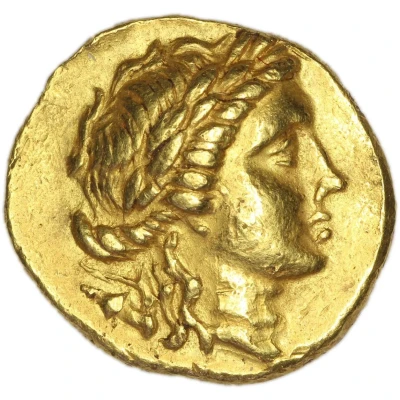


© Leu Numismatik
Stater 130 BC - 120 BC
| Gold | 8.51 g | 20 mm |
| Issuer | Miletos (Ionia) |
|---|---|
| Type | Standard circulation coin |
| Years | 130 BC - 120 BC |
| Value | Stater (20) |
| Currency | Drachm |
| Composition | Gold |
| Weight | 8.51 g |
| Diameter | 20 mm |
| Shape | Round (irregular) |
| Technique | Hammered |
| Demonetized | Yes |
| Updated | 2024-10-10 |
| Numista | N#384941 |
|---|---|
| Rarity index | 100% |
Reverse
Lion standing right, head turned back to left; above, star; in field to right, monogram of MI above monogram of ΙΣ.
Script: Greek
Lettering:
EYMHXAN[OΣ]
MI
ΙΣ
Comment
Attic standard, magistrate Eumechanos.Deppert-Lippitz p. 121, 3-5 and pl. 32, 6.
With Deppert-Lippitz recording a mere five examples in 1984, the late Hellenistic Milesian civic gold coinage is of an exceptional rarity. Unfortunately, much damage was done by her unjustified condemnation of the entire series as doubtful, a judgement that was vehemently contested by P. Kinns in his review of Deppert-Lippitz's monograph (P. Kinns: The coinage of Miletus, in: NC 146 (1986), pp. 233-260, with the relevant discussion on pp. 245-247). There is, as Kinns rightly pointed out, not the slightest evidence that these coins are anything but authentic, and his arguments in favor of them are absolutely persuasive.
Kinns originally dated the series to circa 175-160 BC (Kinns, Miletus, p. 260) and later amended this to 150-130, connecting it to the gold from Ephesos (P. Kinns: Milesian silver coinage in the second century BC, in: Studies Price, p. 182). With the latter now being downdated as well, placing the Milesian gold in circa 130-120 BC appears realistic.
Interesting fact
One interesting fact about this coin is that it features the image of a lion, which was a symbol of power and strength in ancient Greece. The lion was also associated with the god Apollo, who was revered in Miletos, and the coin may have been used as a form of offering to the god. Additionally, the fact that it was made of gold suggests that it was a valuable and prestigious coin, likely used for important transactions or as a symbol of wealth and status.



